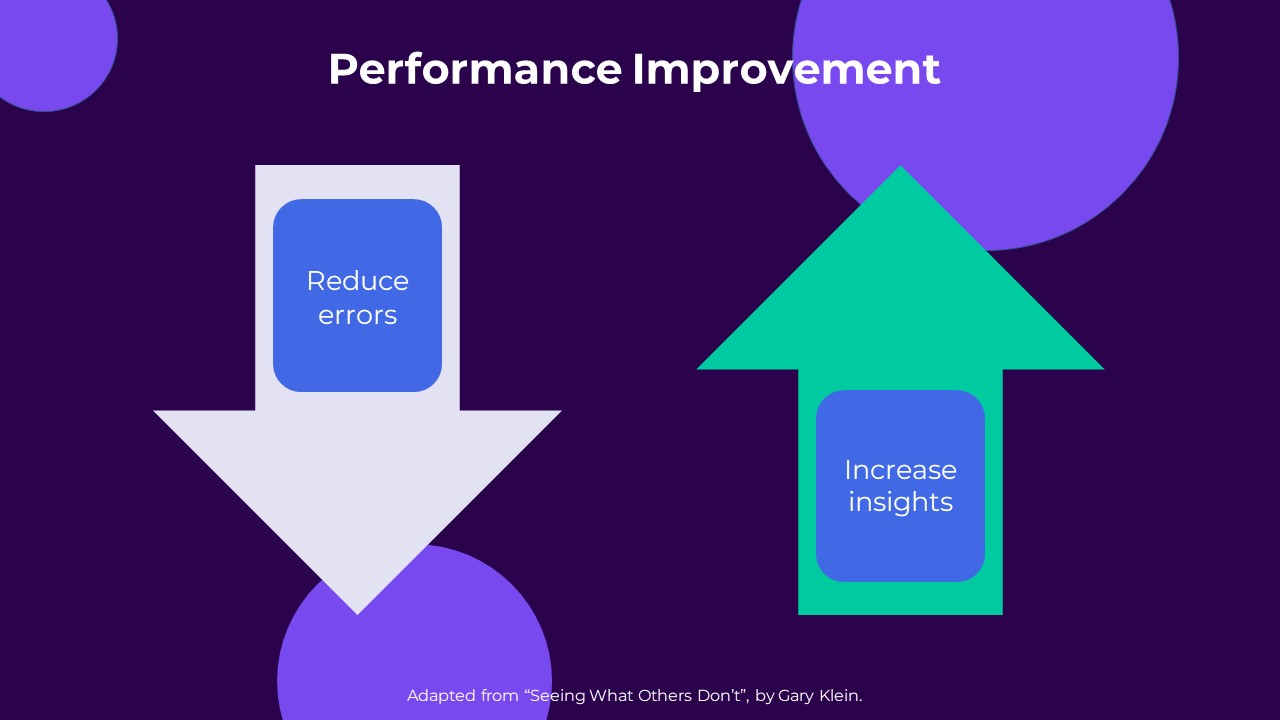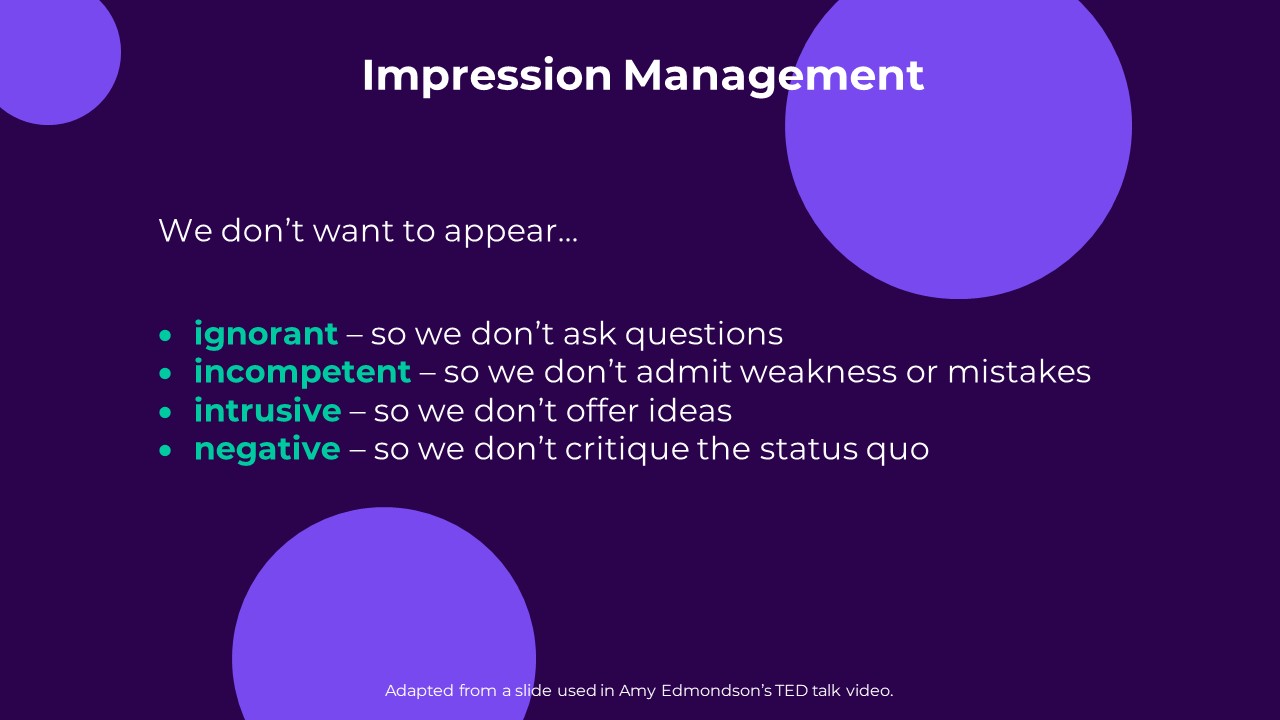To us, these requirements need thriving social interaction and open communication which allows everyone to be themselves and share their ideas and questions. Communication is fundamental to human relationships, and frequent, open and clear communication is key to agile working practices.
A culture of learning is dependent on people feeling empowered to openly discuss working practices in order to make good decisions and seek improvements. This empowerment comes from psychological safety.
The shift in working practices following the global COVID-19 pandemic means that more employees are working remotely at least some of the time. In the “hybrid” workplace, we have far fewer moments chatting at our desks, joking at the coffee machine or socialising after work. In these small moments, we all learn a bit more about each other, our interests, our personalities, what makes us laugh and how we view the world. As a result, good online communication has never been more important.
From their homeworking space, do your team members have an environment in which they can show a bit of their personality and sense of humour? Can they chat about things they’ve been doing that aren’t directly related to their role or projects? It depends on the environment, to an extent, but can they share amusing videos, and communicate with gifs or emojis, while feeling that it is normal to do so?
These kinds of interactions improve working relationships so that communication becomes easier, more open and fluid. Time engaged in communication of this type should be recognised as working time; it isn’t an optional addition to contracted working hours, and people should be trusted not to take this too far. Work can be measured in the quality of output, not by a clock.
Psychological safety empowers people to be themselves in all their interactions, feeling confident to contribute in ways they see fit.
social learning and knowledge sharing
As social learning is increasingly recognised as a fundamental part of the learning landscape within organisations, the need for people to feel able to openly communicate is crucial.
“Social learning refers to “the actions and interactions that build and maintain transparent, open, and trusting relationships at work. These relationships facilitate the sharing of information and ideas, driving collaboration, innovation, learning, and conversations.”
Britz and Tyer, “Social By Design”.
Social learning can take place in any conversation or communication exchange, whether face-to-face, in online meetings or social working spaces, in an informal chat or within a formal learning experience. This communication usually means sharing thoughts, experiences and knowledge. But for several reasons, people often do not share freely and openly in a way that results in a thriving culture of learning focused on performance improvement.
The simple idea that “employees don’t share” may seem mildly trivial, but it has been estimated that Fortune 500 companies suffer losses of $31.5 billion per year because their employees do not share knowledge and experiences. The losses come from things like people “reinventing the wheel”, wasting time searching for things instead of asking, and not sharing their experiences of failure, leading to repeated mistakes.
performance improvement
Knowledge sharing is not only paramount for learning; it also drives creativity and innovation through exposure to a greater number of ideas that lead to people joining dots and generating insights.
In his book “Seeing What Others Don’t”, psychologist Gary Klein proposes a framework to simply explain how to achieve performance improvement, represented by an up arrow and a down arrow.

“To improve performance, we need to do two things. The down arrow is what we have to reduce, errors. The up arrow is what we have to increase, insights. Performance improvement depends on doing both of these things.”
Gary Klein, “Seeing What Other’s Don’t”.
Following this thinking, an organisation’s attempts to focus on performance improvement will suffer greatly if people do not feel empowered to speak up. Unfortunately, there is often a big blockage in the way, and that relates to the level of psychological safety people feel. To foster knowledge sharing and social learning within an organisation, there needs to be a strong focus on ensuring high levels of psychological safety.
psychological safety
Perhaps most associated with Professor Amy C. Edmondson, psychological safety means feeling safe to be yourself, share your thoughts, and make mistakes without fear of being judged or punished. As a member of a supportive team in which everyone respects each other and encourages open communication, you’re more likely to take risks, ask questions and learn – together – from your experiences. This helps people collaborate more effectively, solve problems, and come up with new ideas without an overwhelming concern for “impression management”.
“Psychological safety is the belief that you won’t be punished or humiliated for speaking up with ideas, questions, concerns, or mistakes.”
Center for Creative Leadership
Edmondson identifies four areas in which we aim to manage how we appear to other people.

Psychological safety is fundamental to the success of teams. In a study of their own teams’ work processes, Google identified psychological safety as the number one feature of high-performing teams, meaning that team members felt empowered to ask questions, to share ideas and raise doubts.
Famously, Toyota considered the individual empowerment of their workforce so important to their drive for quality in their products and processes that they literally enabled production line workers to pull a cord (the Andon cord) which stopped the production line if they noticed something was wrong. This is foundational to the Toyota production system built on continuous improvement, known as “kaizen”.
It’s clear that organisations and teams in which employees feel comfortable and confident to raise problems, express doubts, share ideas and ask questions are healthy, “learning organisations”, as defined by Peter Senge. This should lead to collective performance improvement alongside increased results in creativity and innovation.
So, what can be done to foster psychological safety? Here are some ideas to get you started.
8 Top Tips for Fostering Psychological Safety in a Hybrid Working Environment
- Measure Psychological Safety
To know how to support psychological safety and improve it in your organisation, you’ll need to understand the situation clearly. Measure psychological safety levels by conducting an anonymous survey. Ask people to rate statements on a scale of 1–5 to see how strongly they agree with them. Here are some examples to get started:-
I can openly discuss problems and challenges
-
I feel safe to experiment with new processes
-
I feel comfortable asking colleagues or my manager for help
-
My unique skills and talents are valued and utilised
-
If I make a mistake, it may be held against me
When you have some insight into how low levels of psychological safety present themselves, you can create a plan of action to address them.
-
- Promote Autonomous Motivation
People need to WANT to share. They are likely to share more if they are driven by autonomous motivation rather than when forced. Don’t push – empower!
Encourage managers and senior leaders to engage in natural, friendly conversation with their teams and the wider organisation, using platforms that promote open discussions, such as virtual collaboration spaces, instant messaging apps and video conferencing tools. - Embrace Diverse Behaviours
Foster an inclusive environment that celebrates diversity of thought, background and experiences. In terms of online social learning, some people will be positive and share more; others may engage intermittently, and others may not be seen to participate at all – but that doesn’t mean they aren’t reading and acting on what they learn. These different perspectives are valid, and understanding this helps to identify where the missing pieces lie, to shape and refine a learning strategy that works for everyone. With hybrid working in mind, ensure that both remote and office-based team members have equal opportunities to contribute and share their perspectives. - Promote Collaboration
Design collaborative learning activities with opportunities for employees to work together on projects, problem-solving exercises or cross-functional teams. A collaborative environment helps build trust and psychological safety among team members, as well as showcasing different approaches that their colleagues might take. Encourage active listening and make space for dissenting opinions.
Events don’t always have to be directly focused on work. Virtual coffee breaks, online games and quizzes, or any type of informal gathering, can help build rapport and strengthen relationships, fostering trust and collaboration within the team. - Use Feedback to Assess and Improve Together
A culture in which employees feel safe providing and receiving feedback will provide insights into the effectiveness of working processes. Encourage a team feedback culture in which constructive criticism is delivered respectfully and positively, with an emphasis on specific and actionable feedback rather than general criticism.
Adjust feedback methods as appropriate to ensure that psychological safety remains a priority. For instance, in performance and project review meetings, consider focusing on “What happened?”, not “Who did what?”. Then answer questions using “How might we…?” to focus on collaborative improvement. Be sure to acknowledge and celebrate individual and team achievements to reinforce a sense of value and accomplishment. - Learn From Failure
Leading by example is key here. How comfortable do your people feel with talking openly about mistakes they have made? Failure is one of the best drivers for learning. As Nelson Mandela famously said, “I never lose. I either win or learn.”. It may not be easy, but encourage senior leaders to safely share stories of failure and learning. Nobody has made it to a senior position without learning from their mistakes on the way.
In communications about learning, emphasise that mistakes are opportunities for growth and encourage individuals to share their lessons learned. When sharing things like case studies or stories of achievement internally, encourage the inclusion of things that didn’t go well and what was done, or could be done in future, to do those things better. - Encourage Learning About Learning
There is much more to learning than training rooms and eLearning modules, but many people have a set mindset about learning that goes back to their schooldays. In a school environment, the focus is often on never being wrong; regular exams, assessment and grading drive this, but remember the long-term effects of “impression management” as well.
Offer training that directly relates to learning habits and behaviours, as well as transparent references to the importance of psychological safety. Focus on learning from failure, active listening, peer coaching, conflict resolution and the importance of a growth mindset. Support people to develop emotional intelligence, self-awareness and interpersonal skills, as these are all hugely important for developing a learning culture built on a psychologically safe environment. - Model Behaviours
The common theme that links these tips is leading by example. This should be the responsibility of all leaders and the L&D department as a whole. As an L&D team, share your own ideas and experiences with the rest of the organisation, role modelling good sharing behaviours.
When employees experience open communication from leadership, including acknowledgement of failures and vulnerability, they will feel inspired and empowered to do the same. When they see open enthusiasm for collaboration and feedback, this will become infectious and start to feel like everyday professional behaviour.
While the influence of leaders shapes the way employees view all aspects of the workplace, this is never more conspicuous than in social learning.
* This was all highlighted in the 2023 LinkedIn Learning report.
Talk to us today if you would like to find out how we can help you with your L&D offering!







Is this article interesting?